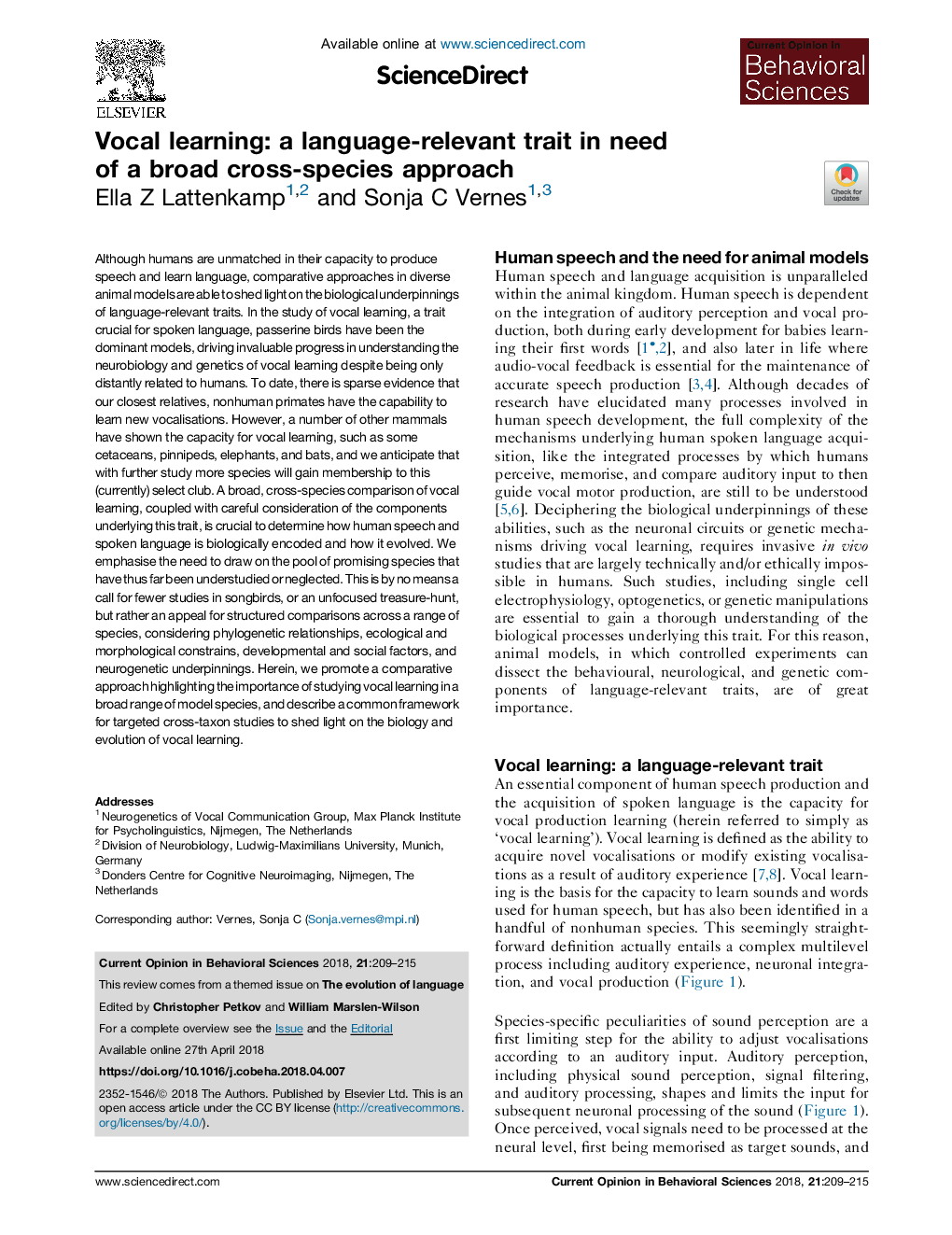| کد مقاله | کد نشریه | سال انتشار | مقاله انگلیسی | نسخه تمام متن |
|---|---|---|---|---|
| 8838128 | 1613069 | 2018 | 7 صفحه PDF | دانلود رایگان |
عنوان انگلیسی مقاله ISI
Vocal learning: a language-relevant trait in need of a broad cross-species approach
ترجمه فارسی عنوان
یادگیری آواز: یک ویژگی مرتبط با زبان که نیاز به یک رویکرد گسترده ای از گونه ها دارد
دانلود مقاله + سفارش ترجمه
دانلود مقاله ISI انگلیسی
رایگان برای ایرانیان
ترجمه چکیده
اگر چه انسان ها در توانایی خود برای تولید گفتار و یادگیری زبان بی نظیر هستند، روش های مقایسه ای در مدل های مختلف حیوانات می توانند بر پایه های زیست شناختی ویژگی های مربوط به زبان بیفزایند. در مطالعه یادگیری صوتی، یک ویژگی بسیار مهم برای زبان گفتاری، پرندگان گذرنشین شده اند مدل های غالب، پیشرفت قابل توجهی در درک نوروفیزیولوژی و ژنتیک یادگیری آوازی، گرچه تنها به دور از ارتباط با انسان است. تا به امروز شواهد پراکندهای وجود دارد که نزدیکترین بستگان ما، اولیای غیر انسانی توانایی یادگیری صداهای جدید را دارند. با این حال تعدادی از پستانداران دیگر ظرفیت یادگیری آوازی مانند بعضی از سیاتا، ریشخند، فیل ها و خفاش ها را نشان داده اند و پیش بینی می کنیم که با مطالعه بیشتر، گونه های بیشتری به عضویت این باشگاه (در حال حاضر) برسند. یک مقایسه گسترده و متقابل بین یادگیری صوتی، همراه با توجه دقیق به اجزای اصلی این ویژگی، برای تعیین اینکه چگونه گفتار و گفتار انسانی بطور زیستی کدگذاری شده است و چگونه آن را تکامل یافته، حیاتی است. ما تاکید بر نیاز به جمع آوری گونه های امیدوار کننده ای که تا کنون از بین رفته اند یا نادیده گرفته شده اند. این به این معنی نیست که مطالعات کمتری در پرندههای پرنده یا شکار گنجینههای نامتعارف داشته باشد، بلکه تجدید نظر برای مقایسه ساختار یافته در میان انواع گونهها، با توجه به روابط فیلوژنتیکی، محدودیتهای محیطی و مورفولوژیکی، عوامل توسعه و اجتماعی و زمینههای نوروژنتیک . در اینجا، ما یک رویکرد مقایسه ای را که اهمیت مطالعه یادگیری آوازی در طیف وسیعی از گونه های مدل را برجسته می کنیم، ترویج می دهیم و یک چارچوب مشترک برای مطالعات متقابل تطبیقی هدف را برای روشن کردن زیست شناسی و تکامل یادگیری صوتی توصیف می کنیم.
موضوعات مرتبط
علوم زیستی و بیوفناوری
علم عصب شناسی
علوم اعصاب رفتاری
چکیده انگلیسی
Although humans are unmatched in their capacity to produce speech and learn language, comparative approaches in diverse animal models are able to shed light on the biological underpinnings of language-relevant traits. In the study of vocal learning, a trait crucial for spoken language, passerine birds have been the dominant models, driving invaluable progress in understanding the neurobiology and genetics of vocal learning despite being only distantly related to humans. To date, there is sparse evidence that our closest relatives, nonhuman primates have the capability to learn new vocalisations. However, a number of other mammals have shown the capacity for vocal learning, such as some cetaceans, pinnipeds, elephants, and bats, and we anticipate that with further study more species will gain membership to this (currently) select club. A broad, cross-species comparison of vocal learning, coupled with careful consideration of the components underlying this trait, is crucial to determine how human speech and spoken language is biologically encoded and how it evolved. We emphasise the need to draw on the pool of promising species that have thus far been understudied or neglected. This is by no means a call for fewer studies in songbirds, or an unfocused treasure-hunt, but rather an appeal for structured comparisons across a range of species, considering phylogenetic relationships, ecological and morphological constrains, developmental and social factors, and neurogenetic underpinnings. Herein, we promote a comparative approach highlighting the importance of studying vocal learning in a broad range of model species, and describe a common framework for targeted cross-taxon studies to shed light on the biology and evolution of vocal learning.
ناشر
Database: Elsevier - ScienceDirect (ساینس دایرکت)
Journal: Current Opinion in Behavioral Sciences - Volume 21, June 2018, Pages 209-215
Journal: Current Opinion in Behavioral Sciences - Volume 21, June 2018, Pages 209-215
نویسندگان
Ella Z Lattenkamp, Sonja C Vernes,
